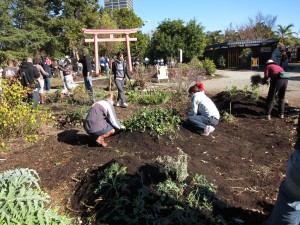 The slow onset of winter rain probably has you wondering whether your planting beds will be wanting for irrigation assistance sooner than you’d like this year.
The slow onset of winter rain probably has you wondering whether your planting beds will be wanting for irrigation assistance sooner than you’d like this year.
The short answer to this is: Yes.
However, amending your beds with compost now – before the heaviest rains arrive – will go a long way to reducing needed irrigation in late spring and summer. Why?
Because compost, like a sponge, is very effective at retaining and then slowly, releasing held moisture. Perhaps more important is that the addition of “living” compost, rich in organic matter, adds beneficial microbes to the soil that facilitate the transport or water and nutrients to plant roots. Soil abundant with these microbial marvels can dramatically reduce the need for summer irrigation, and consequently save use money at the spigot.
Unfortunately, many unknowing gardeners feed their plants with a mined, salty, chemical, fast-acting fertilizer that can deplete the soil, dehydrate the earthworms and turn your plants into ‘heavy drinkers.’ Stop being an enabler! You want to nurture your plants with a slow-release amendment such as compost. Compost has exactly what plants need: water, air, nutrients, and bulk, the last being something most fertilizers lack. Compost improves your soil texture and structure while retaining nutrients and moisture.
The best news is that you don’t even have to bend to till these days. New thinking is not to disrupt the soil life underfoot by digging in compost. Hip, hip, hooray! Simply lay a 2-3 inch layer of compost to the top layer of your raised beds or planting area and let the soil organisms move the organic materials down. Most gardeners think they need to dig the compost to the roots, but you may be surprised to learn that a tall oak tree and a tiny marigold both have the bulk of their feeder roots near the well-aerated surface of the soil.
Lee Reich, soil and plant researcher at for the USDA and Cornell University writes, “Leaving soil undisturbed in spring even helps plants quench their thirst later in the season. Earthworms, roots of various dimensions, even the action of thawing and freezing all work together to create interconnecting large and small pores within which air and water move and new roots grow.” Leaving the organic materials on the surface also provides a landing for raindrops to soak in instead of running off. You may want to pick up a copy of Reich’s Weedless Gardening, detailing his low-impact and low-watering approach to gardening.
Though everyone has their own style of playing in the dirt and can choose what works best for their yard, we agree with Reich, and do minimal digging. Not because we are slackers! But because we know Mother Nature has done her own thing for millions of years, creating soils in this way; from the top down. In the forest, leaf litter falls down and gradually decomposes slowly over time.
A very useful factsheet with easy to follow step-by-step illustrated instructions on the use of compost as a soil amendment for establishing planting beds is available for download free of charge from the U.S. Composting Council.
And, don’t forget to download a free copy of the Bay-Friendly Gardening Guide: From Backyard to the Bay available from the Bay-Friendly Coalition.
Hurry! The rain is coming.
Compost! Compost! Compost!


